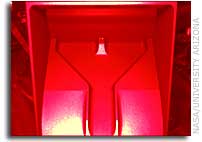NASA Phoenix Mars Lander Camera Sends First Image Back to Earth

A camera flying aboard The University of Arizona-led Phoenix Mars Lander took its first picture during cruise and sent it back to Earth on Sept. 6. The lander’s Robotic Arm Camera took the photo looking into the Robotic Arm’s scoop. Both instruments are encased in a protective biobarrier to ensure no Earth organisms are carried to Mars.
“It is a nice, clean picture with good sharp focus. One of these days it will be filled with Martian dirt,” said Peter Smith, Phoenix principal investigator at the UA. “We have special pride in this, as it is a UA- German product.”
The Robotic Arm Camera took an image of the Robotic Arm scoop using its red LED (Light-Emitting Diode) lamp. Human eyes see this image only in shades of gray, so the picture has been enhanced in false color to better represent what the camera sees. The image is online at the Phoenix Mars Lander Website, http://phoenix.lpl.arizona.edu, as well as the UA News Website, http://uanews.org.
Images from the Robotic Arm Camera, one of five imaging instruments on the lander, will be the only pictures taken and returned to Earth until Phoenix approaches and lands on Mars on May 25, 2008. Additional images will be taken by the Robotic Arm Camera later in the cruise stage. The Robotic Arm Camera check was one of a series of instrument tests being completed as Phoenix cruises toward the red planet. Phoenix was about 57 million miles from Earth when the image was sent back. It is traveling at 76,000 miles per hour in relation to the sun.
On Mars, the Robotic Arm will dig trenches, scoop up soil and water- ice samples and deliver them to several instruments on the lander’s deck for chemical and geological analysis.
The Robotic Arm Camera, built by the UA and Max Planck Institute, is attached to the Robotic Arm just above the scoop. It will provide close-up, full-color images of the Martian surface, prospective soil and water- ice samples, samples collected in the scoop before delivery to the lander’s science deck, and of the floor and side walls of the trenches.
Phoenix’s Robotic Arm was provided by the Jet Propulsion Laboratory, and the arm’s scoop was manufactured by Honeybee Robotics of New York. Phoenix launched from Cape Canaveral Air Force Station, Fla., on Aug. 4. It will fly to a site farther north than any previous Mars landing. The solar-powered lander will robotically dig to underground ice and will run laboratory tests assessing whether the site could have ever been hospitable to microbial life. The instruments will also look for clues about the history of the water in the ice. They will monitor arctic weather as northern Mars’ summer progresses toward fall, until solar energy fades and the mission ends.
The Phoenix mission is led by Peter Smith of The University of Arizona, Tucson, with project management at NASA’s Jet Propulsion Laboratory, Pasadena, Calif., and development partnership at Lockheed Martin, Denver. International contributions are provided by the Canadian Space Agency; the University of Neuchatel, Switzerland; the universities of Copenhagen and Aarhus, Denmark; the Max Planck Institute, Germany; and the Finnish Meteorological Institute.









